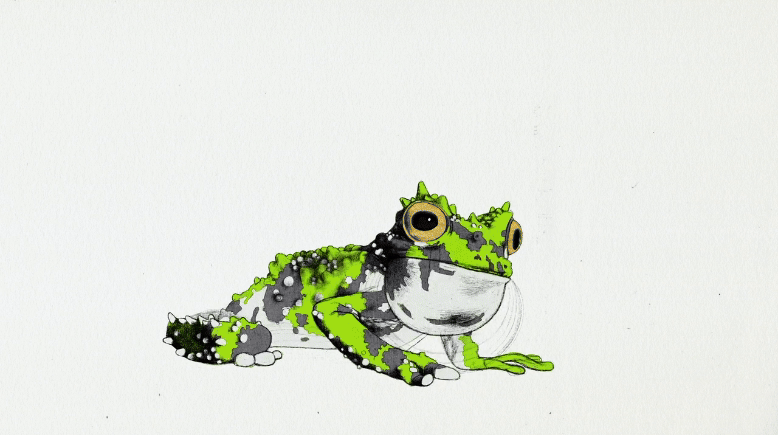This post was originally published on Colossal
“We might call that a cold case, right? There’s no evidence, there’s no murder weapon… It’s a crime scene, but the culprit—the criminal—has left.” Biologist Karen Lips’s opening words in the 2023 animated short film, “The Waiting,” portend a mystery with far-reaching implications.
Directed by Volker Schlecht and written by Alexander Lahl and Max Mönch, the award-winning film traces the mysterious disappearance of tree frogs in Costa Rica. Through a hand-drawn, mostly black-and-white style, rainforest creatures transform from plants, and tiny tadpoles metamorphose into full-grown amphibians.
In the 1990s, Lips undertook research in the Costa Rican rainforest, stationed in a small shack its resident scientists called “la casita,” where she monitored a group of fluorescent green tree frogs, Isthmohyla calypsa. The species possessed unique spikes on their hands that were used as weapons to physically fight for dominance within the habitat.
For nearly two years, she studied the Isthmohyla calypsa’s growth patterns, behavior, and habitat, before returning to the University of Miami to write up her research. When one final experiment prompted her to return to the forest, she arrived only to find that the frogs had vanished. “All of them,” she says.
At first, Lips wondered if the disappearance was the result of something she had done. Had they gotten scared? Had she bothered them too much? Perhaps there hadn’t been enough rain? “I thought… maybe I just need to wait long enough, and they’ll come back,” she says.

After waiting an entire summer, the frogs never reappeared. She was determined to solve the mystery, but no evidence remained to study. “There was no smoking gun,” Lips says. Eventually, she moved to another site to study a new set of frogs. But after a few days, her team began noticing unusual skin problems.
The malefactor turned out to be microscopic fungi known as chytrids, and it wasn’t limited to the mountainous cloud forests of Costa Rica. Researchers in countries across the globe reported similar findings when Lips shared her concerns.
Although it’s impossible to tell how the frogs initially came into contact with the fungus, humans bear the responsibility for their fate, and ultimately, that of many other creatures. The more we import and export food and other organic goods, the more likely invasive—and sometimes dangerous—organisms will spread. “We have made it super easy for infectious diseases of all sorts to leave the jungle and get to a major city in a couple of hours,” she says.
For frogs alone, the effects are considerable: “The estimate is somewhere between 150 and maybe 200 species have gone extinct in the past two or three decades,” Lips says. “Forty-one percent of all amphibians are in decline. And that’s worse than any other group of animals on the planet.”
Find out more about the film on Instagram.


Do stories and artists like this matter to you? Become a Colossal Member today and support independent arts publishing for as little as $7 per month. The article Biologist Karen Lips Investigates Vanishing Tree Frogs in ‘The Waiting’ appeared first on Colossal.





0 Comments